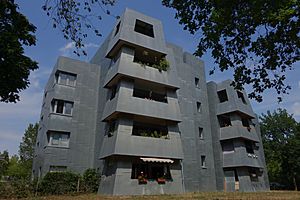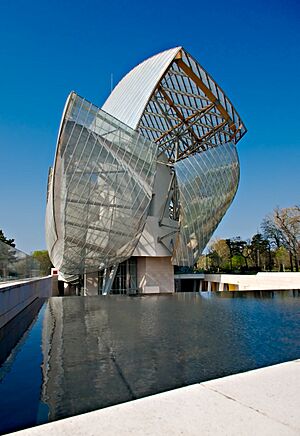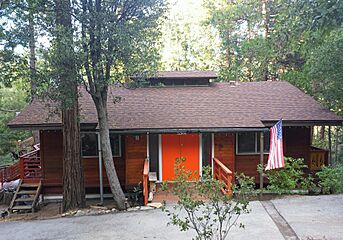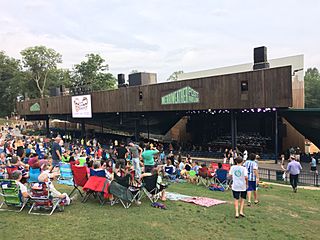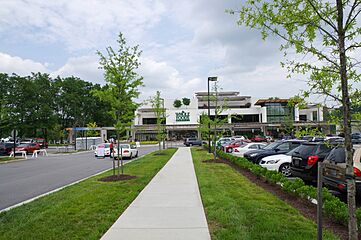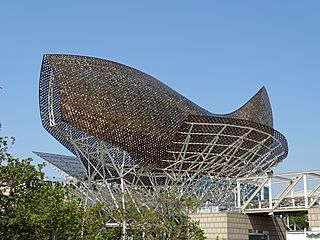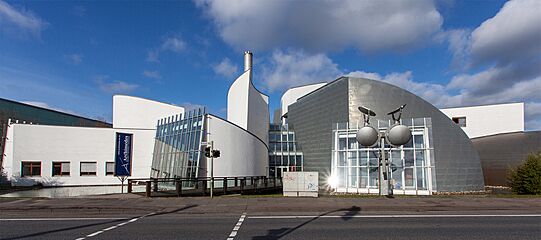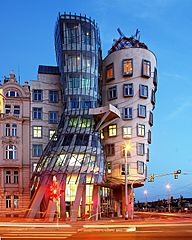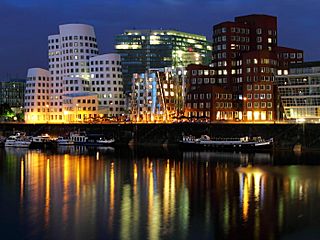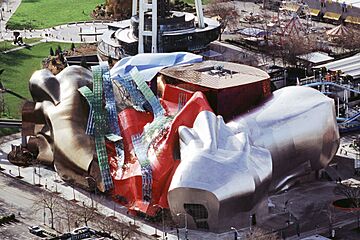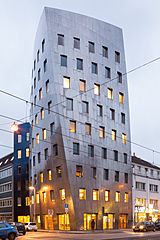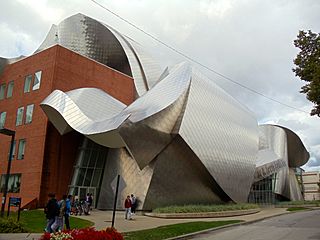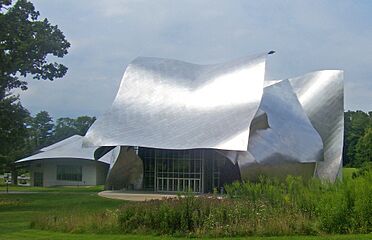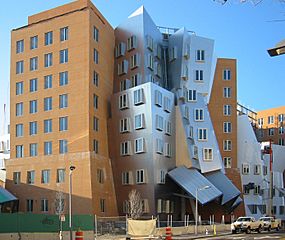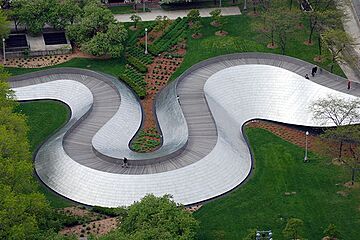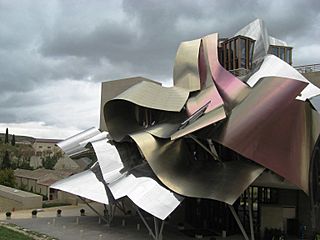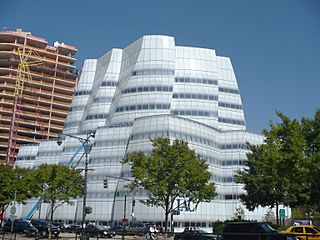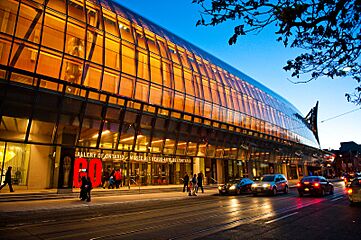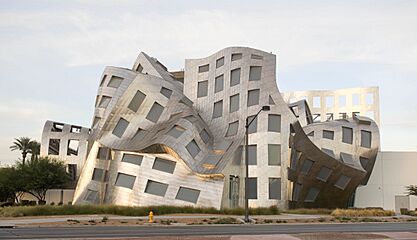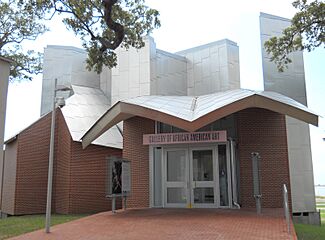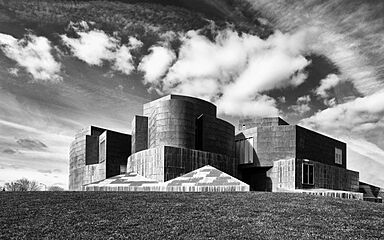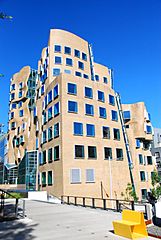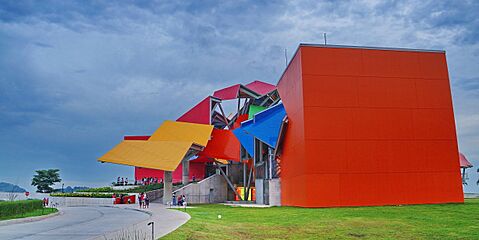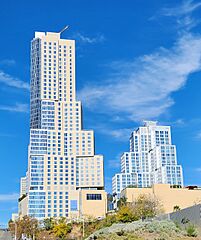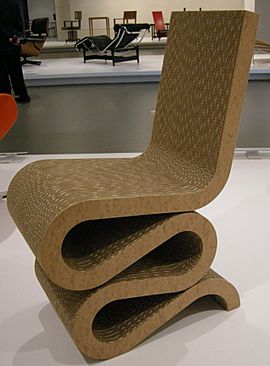Frank Gehry facts for kids
Quick facts for kids
Frank Gehry
|
|
|---|---|
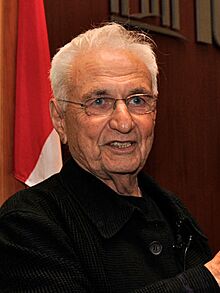
Gehry in 2010
|
|
| Born |
Frank Owen Goldberg
February 28, 1929 Toronto, Ontario, Canada
|
| Died | December 5, 2025 Santa Monica, California, U.S.
|
| Citizenship |
|
| Occupation | Architect |
| Spouse(s) |
Anita Snyder
(m. 1952; div. 1966)Berta Isabel Aguilera
(m. 1975) |
| Children | 4 |
| Awards | List of awards |
| Practice | Gehry Partners, LLP |
| Buildings | List of works |
| Design | |
Frank Owen Gehry (pronounced GAIR-ee; born Frank Owen Goldberg; February 28, 1929 – December 5, 2025) was a famous Canadian-American architect and designer. He was known for creating buildings that look like sculptures, using unusual shapes and materials. Many of his designs, like his own home in Santa Monica, California, became popular attractions.
Gehry became well-known in the 1970s for his unique style. He mixed everyday materials with complex, flowing structures. People often described his architecture as "deconstructivist," meaning it looked like parts were broken apart and put back together in new ways. His work is considered some of the most important in modern architecture. Vanity Fair magazine even called him "the most important architect of our age."
He was famous for his bold and unconventional designs. Some of his most recognized buildings include the Guggenheim Museum Bilbao in Spain, the Walt Disney Concert Hall in Los Angeles, and the Louis Vuitton Foundation in Paris. These buildings often have wavy, sculptural outsides and use materials like shiny titanium and stainless steel.
Throughout his career, Gehry received many awards. This included the Pritzker Architecture Prize in 1989, which is like the Nobel Prize for architecture. He also received the National Medal of Arts and the Presidential Medal of Freedom in the United States. Gehry's creativity wasn't just for buildings; he also designed furniture, jewelry, and even bottles.
Contents
Early Life and Creative Beginnings
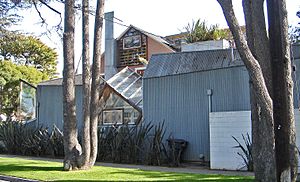
Frank Owen Gehry was born Frank Owen Goldberg on February 28, 1929, in Toronto, Ontario, Canada. His parents were Sadie Thelma and Irving Goldberg. His father was from New York City, and his mother was an immigrant from Poland.
As a child, Frank was very creative. His grandmother, Leah Caplan, encouraged him. They would build small cities together using scraps of wood from her husband's hardware store. These hours of building imaginary houses and futuristic cities on the living room floor sparked his imagination.
Frank's early use of materials like corrugated steel, chain-link fencing, and unpainted plywood was partly inspired by his time at his grandfather's hardware store. His father encouraged him to draw, and his mother introduced him to art. Frank once said, "The creative genes were there." He added that his mother always pushed him to explore his talents.
In 1954, Frank changed his last name from Goldberg to Gehry.
Learning to Design and Build
In 1947, Frank's family moved to California in the United States. He worked as a delivery truck driver and studied at Los Angeles City College.
Frank shared how he found his path: "I was a truck driver in L.A., going to City College. I tried radio announcing, but I wasn't good at it. I tried chemical engineering, which I didn't like. Then I remembered what I truly enjoyed. I loved going to museums and looking at paintings. I loved listening to music. My mother introduced me to these things. I also remembered building with blocks with my grandma. So, I decided to try some architecture classes."
Frank graduated from the University of Southern California's USC School of Architecture in 1954. After graduation, he worked in various jobs, including serving in the United States Army. In 1956, he moved his family to Cambridge, Massachusetts, to study city planning at Harvard University's Harvard Graduate School of Design.
Frank believed architecture should help society. However, he felt disappointed at Harvard. He left his graduate program after learning that one of his professors was designing a palace for a dictator. Frank felt this went against his ideas of responsible architecture.
Building a Vision: Frank Gehry's Career
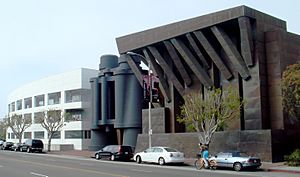
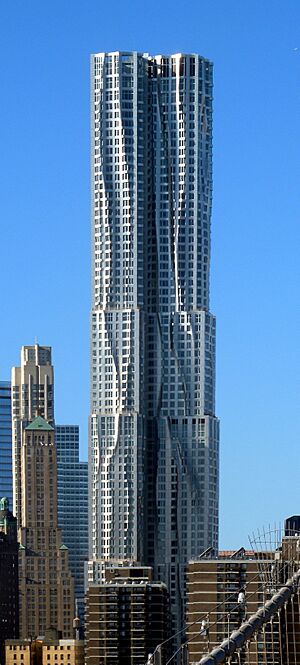
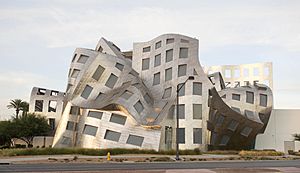
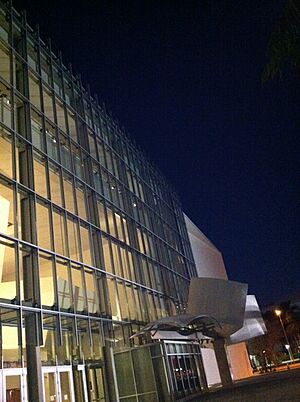
After leaving Harvard, Gehry started a company called Easy Edges. It made furniture out of cardboard. He then returned to Los Angeles to work for an architecture firm.
In 1957, at age 28, he designed his first private home. This "David Cabin" in Idyllwild, California, showed early signs of his unique style. It had beams sticking out and exposed ceiling parts. It also had influences from Asian architecture.
In 1961, Gehry worked in Paris. A year later, he opened his own architecture firm in Los Angeles. His early projects were mostly in Southern California. He designed innovative commercial buildings like Santa Monica Place (1980) and homes like the unusual Norton House (1984).
One of his most famous early designs was the renovation of his own home in Santa Monica. Built in 1920, Gehry bought it in 1977. He wrapped the original house with a metallic exterior, leaving many of the old details visible. This made his home a striking example of his style.
Other buildings from the 1980s include the Cabrillo Marine Aquarium (1981) and the California Aerospace Museum (1984).
In 1989, Gehry received the Pritzker Architecture Prize. The jury praised his willingness to experiment and his ability to create "juxtaposed collages of spaces and materials." They said his buildings made people appreciate both the "theatre and the back-stage."
Gehry continued to design many important buildings. These included the Chiat/Day Building (1991) in Venice, California, which features a giant sculpture of binoculars. He also started getting big projects internationally. His first European project was the Vitra International Furniture Manufacturing Facility and Design Museum in Germany (1989). Other major works followed, like the Frederick Weisman Museum of Art (1993) in Minnesota and the Dancing House in Prague (1996).
From 1994 to 1996, Gehry designed public housing in Frankfurt, Germany. In 1997, he became world-famous when the Guggenheim Museum Bilbao opened in Spain. Critics called it a "masterpiece of the 20th century." This museum became known for its amazing design and how it helped the city's economy.
After Bilbao, Gehry regularly won major commissions. He became one of the world's most recognized architects. His concert halls are especially well-loved. The Walt Disney Concert Hall (2003) in Los Angeles is a lively, curvy building that helped revitalize its neighborhood. The Los Angeles Times called it "the most effective answer to doubters." He also designed the Jay Pritzker Pavilion (2004) in Chicago and the New World Center (2011) in Miami Beach.
Other notable works include academic buildings like the Stata Center (2004) at MIT. He also designed museums like the Museum of Pop Culture (2000) in Seattle. His first skyscraper, 8 Spruce Street (2011) in New York City, is also a famous residential building.
His more recent international works include the Dr Chau Chak Wing Building (2014) in Sydney, Australia. This building has 320,000 bricks in "sweeping lines." Other projects included the Guggenheim Abu Dhabi and the Forma skyscraper in his hometown of Toronto.
Some of Gehry's designs faced delays or changes. For example, his design for the Dwight D. Eisenhower Memorial in Washington, D.C., had many delays. However, it was finally approved in 2014 with a modified design.
In 2014, two important museums designed by Gehry opened. These were the Biomuseo in Panama City, Panama, and the Louis Vuitton Foundation in Paris, France. Both received positive reviews. Also in 2014, Gehry was asked to create a new plan for the Los Angeles River.
In February 2015, the new building for the University of Technology Sydney opened. Gehry said he would not design another building like the "crumpled paper bag" again.
In the 2020s, notable Gehry-designed buildings included the Dwight D. Eisenhower Memorial and the LUMA Arles museum in France. By 2021, many significant projects in Los Angeles, his adopted home, were completed. These included the Grand Avenue Project and a concert hall for the Youth Orchestra Los Angeles.
Frank Gehry's Unique Architectural Style
Frank Gehry's work is hard to put into one category. It shows a spirit of trying new things while still respecting the rules of building. His early training was in modernism, but he wanted to move beyond its typical look. He was known for creating buildings that are "fun, sculpturally exciting, good experiences."
Sometimes, Gehry's style looked unfinished or even rough. This was similar to the "Funk art" movement of the 1960s and 1970s in California. This art used inexpensive, everyday objects to create serious art. His buildings often had elements of deconstructivism. This means they looked like they were taken apart and put back together in unexpected ways. He was even called "the apostle of chain-link fencing and corrugated metal siding." However, an exhibit in 1988 showed that he was also a skilled artist who understood art history.
His Design Ideas
Gehry believed that architecture was like sculpture. He said, "I always thought that architecture was, by definition, a three-dimensional object, therefore sculpture." This shows how much he wanted to combine art and building design. His early work with sculptors helped him experiment with breaking traditional building shapes. He liked to create a sense of flow and make familiar things look new and surprising.
His background also influenced his designs. He often reinterpreted traditional shapes in ways that reflected his diverse experiences. His buildings were seen as challenging ideas of luxury. Instead, they focused on pure creativity.
Gallery
-
David Cabin – Idyllwild, CA (1957)
-
Neuer Zollhof - Düsseldorf (1998)
-
Museum of Pop Culture – Seattle (2000)
-
Gehry Tower – Hanover (2001)
-
Weatherhead School of Management – Cleveland, Ohio (2002)
-
Walt Disney Concert Hall – Los Angeles (2003)
-
BP Pedestrian Bridge – Chicago (2004)
-
Marqués de Riscal Hotel – Elciego (2006)
-
IAC headquarter – Manhattan, New York (2007)
-
Art Gallery of Ontario – Toronto (2008)
-
Lou Ruvo Center – Las Vegas (2010)
-
Toledo Museum of Art – Toledo, Ohio (2013)
The "Bilbao Effect"
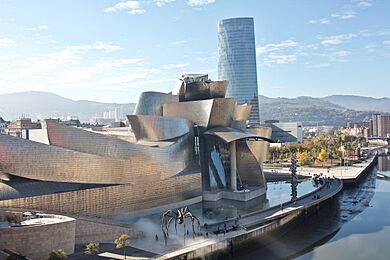
The term "Bilbao effect" describes how Gehry's architecture changed cities. His design for the Guggenheim Museum in Bilbao, Spain, brought new life to the city. It became a great example of how a building can boost a city's economy and culture. The museum's dramatic curves and shiny titanium panels are key features of Gehry's style. They show movement and fluidity.
After the huge success of the Guggenheim Museum in Bilbao, people started talking about the "Bilbao effect." This meant cities could become more lively and prosperous through amazing, new architecture. In its first year, the museum added about $160 million to the local economy. By 2014, over $3.5 billion had been added. Many cities have tried to copy this effect with their own eye-catching buildings. Some have been successful, like Gehry's Walt Disney Concert Hall in Los Angeles. Others, like the Museum of Pop Culture in Seattle, were more debated.
Beyond Buildings: Teaching and Other Designs
Teaching Architecture
In 2011, Frank Gehry joined the faculty at the University of Southern California (USC). He taught architecture there, at his old university. He also taught at other famous universities, including Harvard University, Yale University, and the University of Toronto.
He received many honorary degrees from universities, recognizing his contributions to architecture.
Designing Exhibitions and Stages
Gehry also designed spaces for art exhibitions. He created displays for shows at the Los Angeles County Museum of Art (LACMA) for many years. He also designed the installation for "The Art of the Motorcycle" exhibition at the Solomon R. Guggenheim Museum in 1998.
He also used his creativity for stage design. In 1983, he designed the stage for a dance performance called Available Light. In 2012, he designed the set for an opera, Don Giovanni, performed at his own Walt Disney Concert Hall.
Other Creative Works
Besides buildings, Gehry designed many other things. He created furniture lines, like "Easy Edges" made from cardboard. He also designed jewelry for Tiffany & Co., various household items, and even a glass bottle for Wyborowa Vodka. He first started designing furniture while serving in the U.S. Army in 1954.
Frank Gehry was often inspired by fish. He said, "It was by accident I got into the fish image." He noticed that other architects were looking back to Greek temples for inspiration. He thought, "Three hundred million years before man was fish....if you gotta go back...go back three hundred million years ago. Why are you stopping at the Greeks?" So, he started drawing fish.
This fascination led to his first Fish Lamps, made between 1984 and 1986. They were wire frames shaped like fish, covered with pieces of plastic laminate. The fish became a recurring theme in his work, appearing in sculptures like the Fish Sculpture in Barcelona (1989–92).

He also collaborated with the luxury jewelry company Tiffany & Co. He created six different jewelry collections for them. In 2004, Gehry designed the official trophy for the World Cup of Hockey. He redesigned it again for the 2016 tournament. In 2014, he was one of six "iconoclasts" chosen by Louis Vuitton to design a piece using their famous monogram pattern. In 2015, Gehry designed his first yacht.
Personal Life and Philanthropy
Frank Gehry was a naturalized U.S. citizen but also kept his Canadian citizenship. He lived and worked in Santa Monica, California. Growing up in Canada, he was a big fan of ice hockey. He even started a hockey league in his office called FOG, which stood for Frank Owen Gehry.
In 1952, Gehry married Anita Synder, and they later divorced in 1966. In 1975, he married Berta Aguilera. He was survived by his wife, Berta, and three children. Frank Gehry passed away from a respiratory condition at his home in Santa Monica on December 5, 2025, at the age of 96.
Giving Back to the Community
Gehry was also involved in many charitable activities. In 2014, he helped start Turnaround Arts: California. This non-profit organization helps bring art programs to public elementary and middle schools that don't have many resources. He served on their board and worked with students as a visiting artist.
He also donated his time to design projects for free. In 2014, he started working on the L.A. River Master Plan without charging a fee. In 2015, he designed a building for the Children's Institute in Watts, an organization that helps families affected by violence and poverty. The Youth Orchestra Los Angeles (YOLA) also received a free design from Gehry for their educational and performance center. This center provides free instruments and music training to students from disadvantaged neighborhoods. It was completed in 2021.
Frank Gehry's Lasting Legacy
Frank Gehry is considered one of the most important architects of the 20th century. The Guardian newspaper called him "the most recognizable American architect since Frank Lloyd Wright." The New York Times described him as a "Titan of Architecture" and credited him with designing some of the world's most famous buildings. The Los Angeles Times said Gehry "transformed Los Angeles' urban landscape."
Gehry was one of the first architects to understand how computers could help design buildings in new ways. He also created the "Bilbao effect," which showed how a single museum could revitalize a city's economy. The BBC noted that when Gehry redesigned his own Santa Monica home using chain-link fencing, plywood, and corrugated steel, it "built his daring reputation."
Awards and Honors
- 1974: Fellow of the American Institute of Architects
- 1977: Arnold W. Brunner Prize in Architecture
- 1986: Distinguished Architect Award from the American Institute of Architects (Los Angeles Chapter)
- 1987: Fellow of American Academy of Arts and Letters
- 1988: Elected into the National Academy of Design
- 1989: Pritzker Architecture Prize
- 1992: Praemium Imperiale
- 1994: The Dorothy and Lillian Gish Prize
- 1994: Thomas Jefferson Medal in Architecture
- 1995: American Academy of Achievement's Golden Plate Award
- 1995: Chrysler Award of Innovation in Design
- 1998: National Medal of Arts
- 1998: Inaugural Austrian Frederick Kiesler Prize for Architecture and the Arts
- 1998: Gold Medal Award, Royal Architectural Institute of Canada
- 1999: AIA Gold Medal, American Institute of Architects
- 2000: Cooper–Hewitt National Design Award Lifetime Achievement
- 2002: Companion of the Order of Canada (CC)
- 2004: Woodrow Wilson Award for Public Service
- 2006: Inductee, California Hall of Fame
- 2007: Henry C. Turner Prize for Innovation in Construction Technology from the National Building Museum (on behalf of Gehry Partners and Gehry Technologies)
- 2012: Twenty-five Year Award, American Institute of Architects
- 2014: Prince of Asturias Award
- 2014: Commandeur of the Ordre National de la Légion d'honneur, France
- 2015: J. Paul Getty Medal
- 2016: Harvard Arts Medal
- 2016: Leonore and Walter Annenberg Award for Diplomacy through the Arts, Foundation for Arts and Preservation in Embassies
- 2016: Presidential Medal of Freedom
- 2018: Neutra Medal
- 2019: Inductee, Canada's Walk of Fame
- 2020: Paez Medal of Art, New York City (VAEA)
Gehry was elected to the College of Fellows of the American Institute of Architects (AIA) in 1974, and he received many national, regional and local AIA awards. He was a senior fellow of the Design Futures Council and served on the steering committee of the Aga Khan Award for Architecture.
Honorary Degrees
- 1987: California Institute of the Arts
- 1987: Rhode Island School of Design
- 1989: Otis College of Art and Design
- 1989: Technical University of Nova Scotia
- 1993: Occidental College
- 1995: Whittier College
- 1996: Southern California Institute of Architecture
- 1998: University of Toronto
- 2000: Harvard University
- 2000: University of Edinburgh
- 2000: University of Southern California
- 2000: Yale University
- 2002: City College of New York
- 2004: School of the Art Institute of Chicago
- 2013: Case Western Reserve University
- 2013: Princeton University
- 2014: Juilliard School
- 2015: University of Technology Sydney
- 2017: University of Oxford
- 2019: Southern California Institute of Architecture
See also
 In Spanish: Frank Gehry para niños
In Spanish: Frank Gehry para niños
- Contemporary architecture
- Organization of the artist
- Thin-shell structure


